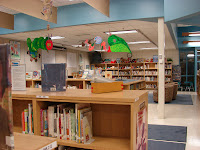
The view from the cozy reading alcove was pleasant but deceiving today. Sunshine and shadow provided many shades to the snow, and the wind whipped the tree branches (causing sub-zero wind chills). Students were stuck indoors for recess yet again. Somehow, though, whenever they come to the library, they are calm and eager to listen.
On the story steps and on the carpet of the alcove, I read aloud A Sick Day for Amos McGee by Philip Stead. It won the 2011 Caldecott Medal for his wife, Erin Stead. I love this story about a many who works in a zoo but makes time for special activities with his animal friends. When he gets sick, they make an unlikely trip to visit him and do special things to make him feel better. Listeners today loved it as well. Midway through the book, there is a pause in the text for three double-page spreads. The elephant, the tortoise, the penguin, the rhinoceros, and the owl leave the zoo, line up at the bus stop, and travel on the number five bus to visit Amos McGee at home.
I read upside down so listeners can view the pages right-side up at all times. As I turned these wordless pages, I observed the height of visual literacy. Children's eyes scanned the pages. Their heads turned to see more. They nodded and smiled. Seeing the number five bus filled with animals, many laughed. One child sighed as his secret prediction about the animals' destination was confirmed. The children never questioned how the animals entered Amos's home; they just accepted their presence and expressed gladness for the things they did to care for Amos.
They gazed at the last wordless page where the human and animals are crowded together in and around the bed. Only penguin is awake, watching a red balloon float to the moon. Immediately, hands rose. One after another, they noted the presence of a balloon on the pages where the penguin was featured. Some came forward to turn the pages for me and point out when there was not a red balloon. They offered theories about how the penguin got another balloon after one rises into the air at the bus stop: it had "secret penguin pockets" with more balloons to fill; someone gave it a new one; it must have reached up with its long flipper. They turned the book all around and saw balloons on the front, back, and spine (that was the most amazing thing).
Children take in so many visual cues. I mentioned none of the balloon images to them. I did not ask about why the elephant and Amos are playing cards on the book jacket while the only played chess in the story...yet someone brought up that point. They noticed Amos's bunny slippers, the mouse that holds so many objects, and Amos's teddybear. Children possess innate visual literacy skills, and time to foster them and practice with books is essential.
My favorite line, by the way, comes when Amos and the tortoise are going to play hide-and-seek instead of running their usual race: "The tortoise hid inside his shell. Amos hid beneath the covers."
























